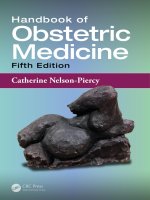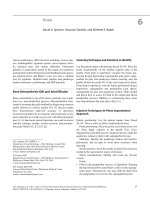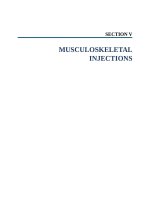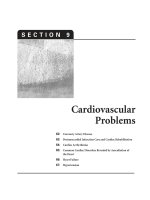Ebook Atlas of pain medicine procedures: Part 2
Bạn đang xem bản rút gọn của tài liệu. Xem và tải ngay bản đầy đủ của tài liệu tại đây (9.49 MB, 890 trang )
SECTIONV
MUSCULOSKELETAL
INJECTIONS
CHAPTER50
FluoroscopyandUltrasound-Guided
JointInjections
JenniferSolomon,ChristineRoque-Dang,andJamesWyss
IMAGE-GUIDEDPERIPHERALJOINT
INJECTIONINDICATIONS
The most common clinical indication for an image-guided interventional
procedureispaininthetargetedanatomiclocation,whichhaseitherfailedother
conservativetreatmentsorasanadjunctivetreatment.Theprimaryadvantageof
image-guided interventional procedures over blind injections includes needle
placement confirmation and the ability to view the targeted area and relevant
anatomy.
Corticosteroidinjectionsarefrequentlyusedasconservativetreatmentsinthe
management of various conditions, including osteoarthritis, tendonitis, bursitis,
and impingement conditions. Injectate mixtures typically comprise a local
anesthetic and a corticosteroid (triamcinolone or methylprednisolone). In
addition, patients at higher risk for developing nonsteroidal anti-inflammatory
drug (NSAID)–induced renal dysfunction or gastric and duodenal ulcers are
candidates for intra-articular steroid injections to avoid the potential systemic
effects that occur with oral anti-inflammatory medications. However, the
detrimental effects of repeated steroid injections on soft tissue structures like
articularcartilageandtendonshavenotyetbeendetermined.
The advantages of ultrasound-guided percutaneous interventional procedures
areasfollows:
•Real-timeassessment
•Guidance,andcontinuousneedlevisualization
•Lackofradiationexposure
•Technologicalportability
•Relativelylowcost
•Improvedaccessibility
Fluoroscopic guidance also allows real-time needle visualization and the
acquisitionofimagingframesthroughouttheinjectioncourse.Thevisualization
occurs at different C-arm angles. The primary disadvantage of fluoroscopy is
radiationexposuretoboththepatientandphysician.
BASICCONCERNSANDCONTRAINDICATIONS
With therapeutic interventions, the benefits and risks of the procedure must be
considered.Generally,peripheraljointcorticosteroidinjectionsareconsideredto
be safe and conservative treatments. However, each patient’s risk factors for
complicationsmustbecarefullyconsideredpriortoundergoingtheprocedure.
Somebasicconcernsforinjectionarefollowing:
•Patientswithprimaryormetastatictumorsinthetargetarea
•Immunocompromisedpatients,whoareatincreasedriskforinfection
•Patientswiththrombocytopenia
•Patientswhomaybeunabletotoleratepositioning
•Patientswithallodyniaorcomplexregionalpainsyndrome(CRPS),whowill
beunabletotoleratetheprocedure
•Patientsonanticoagulantmedications,whohavebeenunabletostopthese
medicationsatanappropriatetimeinterval
•Forfluoroscopicallyguidedprocedureswiththeuseofcontrastdye,patients
withallergiestocontrast,shellfish,oriodinemaybeconsideredfor
interventionalprocedureswithoutcontrast
Contraindicationsforinjectioninclude:
•Infection,systemicorlocalized
•Coagulopathy
•Distortedorcomplicatedanatomy
•Pregnancyforfluoroscopicallyguidedprocedures
•Patientrefusal
GENERALIMAGE-GUIDEDINTERVENTIONAL
PROCEDUREPREOPERATIVE
CONSIDERATIONS
•Informedconsentmustbeobtainedandtherisksandbenefitsoftheprocedure
shouldbeproperlyexplainedtothepatientorconsentingindividual.
•Theareamustbeexaminedforinfection,skinlesions,anddiseaseextent.
•Properexposureofthetargetedareaisnecessary.Ifclothingisrestrictive,the
patientshouldberequestedtochangeintoagown.
•Ideally,thepatientshouldbeabletoremainintheappropriateposition
throughouttheprocedure.
•Intravenousaccessisnotnecessary,butmaybeconsideredifthepatienthasa
historyofpostproceduralvasovagalorhypotensionresponses.
•Thepatientmustbeaskedwhetherheorshetakesanyanticoagulant
medications(ie,aspirin,NSAIDs,etc)and,ifapplicable,whenthese
medicationswerestoppedpriortotheprocedure.Ifstoppingtheanticoagulant
medicationsincreasescardiacrisks,itishighlyrecommendedtoobtain
medicalclearancefromthepatient’scardiologist.
•Thephysicianperformingtheprocedureshouldhaveaccesstofluoroscopyor
ultrasound.
•Forfluoroscopicallyguidedprocedures,femalepatientsinreproductiveage
shouldbeaskedaboutpotentialpregnancyandmayrequireaurinepregnancy
test.
•Forfluoroscopicallyguidedshoulderinjections,thepatientmustbeasked
aboutpriorallergicreactionstocontrast,shellfish,andiodine.
BASICULTRASONOGRAPHY
Depending on the ultrasound probe and machine used, the shoulder, hip, and
elbow regions may be examined with high-frequency (>10 MHz) linear array
transducers. If the patient has a large body habitus, a mid-range frequency
transducer (6-10 MHz) may need to be used to optimize image resolution and
facilitate proper examination. An appropriate initial depth is 3 cm. Also, the
frequencymaybeadjustedtovisualizedeeperstructures(ie,glenoidlabrumor
labrumofthehip)orshallowerones(ie,acromioclavicularjoint[AC]joint).
For ultrasound examination, tissues are described by their properties of
echogenicity,echotexture,degreeofanisotropy,compressibility,andbloodflow
on Doppler examination. Blood vessels are not susceptible to anisotropy, but
exhibitcompressibilityandpresenceofbloodflowonDopplerexamination.In
theshoulder,rotatorcufftendonsdisplayahighdegreeofanisotropy,whichis
particularlypronouncedatthemusculotendinousjunction.
Tissueechogenicityischaracterizedashyperechoic,hypoechoic,anechoic,or
isoechoic.Duetolack of echoes, anechoicstructureshaveablackappearance.
Isoechogenic tissues have similar brightness in comparison with surrounding
tissues. Hyperechoic structures (ie, normal tendons and ligaments) appear
brighter than adjacent tissues. In contrast, hypoechoic structures appear darker
thansurroundingstructures.Bothmusclesandnerveshavemixedechogenicity
patterns.Bloodvesselseitherappeartobehypoechoicoranechoic.
Echotexturereferstotheinternalpatternofechoesandmayvarybasedonthe
axisusedtoassessthestructure.Bothtendonsandligamentshave“broomend”
appearance when viewed in the transverse axis and a fibrillar pattern when
viewed in the longitudinal axis. Nerves have a “honeycomb” appearance on
transverse imaging and a fascicular pattern on longitudinal imaging. Muscles
havea“starrynight”appearanceonatransverseaxisandapennateor“feather
like”patternonalongitudinalaxis[7,9].
BASICPOSTPROCEDUREFOLLOW-UP
The patient should be contacted via telephone on the day following the
interventional procedure to determine pain relief achieved from the local
anesthetic and if there were any complications. If the patient received a
corticosteroid injection, the patient should be reminded that the antiinflammatorypropertyhasavariableonsetandmaytakeupto2to3weeksto
achieve symptomatic improvement. The primary postinjection concern is
infection.Therefore,thepatientshouldmonitortheinjectionsiteforerythema,
warmth,increasedswellingorsystemicfeaturesofaninfection,includingfever
andchills.Ifthepatientdevelopsanycomplications,heorsheshouldbeadvised
to contact the injectionist for further guidance. For severe procedurally related
adverseevents,ie,fever>101°F,weakness,dyspnea,severepainexacerbation,
etc, the patient should be recommended to seek immediate emergency medical
servicesandtonotifytheinjectionist.Alladversereactionsshouldbeproperly
documentedinthepatient’schart.
ClinicalPearls
•Image-guidedinterventionalproceduresarepowerfuldiagnosticand
therapeutictoolstoaidinthediagnosisandmanagementofvarious
musculoskeletaldisorders.
•Thedurationofbenefitisvariable,butsteroidinjectionstendtoproduce
substantialshort-termreliefofsymptoms(eg,pain,swelling)withvariable
durationofrelief(1-3months).
•Bodyhabitusmayinfluencetheimage-guidedapproachused.Inobese
patients,fluoroscopymaybeusedtoimprovevisualizationofdeeper
anatomicstructuresthatwouldbemoredifficulttovisualizeunderultrasound
guidance.Conversely,inleanerpatients,useofultrasoundguidance
eliminatesradiationexposureandusuallymostanatomicstructurescanbe
easilyidentified.
•Successofimage-guidedproceduresisdependentonnumerousfactors,which
includetargetlocalizationthroughuseofanatomiclandmarks,patient
cooperation,andtheexperienceofthephysicianwithimage-guided
interventions.
•Image-guidedinjectionsarewelltoleratedandhaveanexcellentsafety
profile.
•Theseprocedurescanberepeatedtomanagerecurrentsymptoms,butpatients
shouldbecautionedthatthedetrimentaleffectsofrepeatedsteroidinjections
onsofttissuestructures,ie,articularcartilageandtendonshavenotyetbeen
determined.
THEGLENOHUMERAL(GH)JOINTOFTHE
SHOULDER
Indications
The glenohumeral joint of the shoulder is susceptible to premature arthritic
development from various conditions that may damage the joint cartilage. Of
these conditions, glenohumeral osteoarthritis is the most common form of
arthritisthatresultsinshoulderjointpain.Theindicationsinclude:
•Glenohumeralosteoarthritis
•Rotatorcuffarthropathy
•Post-traumaticosteoarthritis
•Acuteandchronicadhesivecapsulitis
•Rheumatoidarthritis
•Collagenvasculardiseases
Oftentimes,patientspresentwithgeneralizedshoulderandupperarmpainand
it may be difficult to localize the primary pain generator intra-articular
glenohumeral joint injections are excellent diagnostic tools, which can aid in
elucidating the primary pain generator. Therapeutically, intra-articular
glenohumeral joint corticosteroid injections are relatively safe interventional
procedures. These procedures may be performed if shoulder pain remains
refractory to more conservative measures such as occupational therapy,
pharmacologic intervention, and activity modification. Accuracy of blind
glenohumeraljointinjectionshasbeenfoundtobeextremelyvariable,ranging
from 25% to 95% accuracy. Image-guided intra-articular glenohumeral joint
injection enables dynamic real-time visualization of the process, improves
needle visualization, augments target accuracy, reduces damage to surrounding
structures, ie, glenoid labrum, and decreases the risk of neurovascular injury,
particularlytothebrachialplexus.
RelevantAnatomy
The large and round head of the humerus articulates with the relatively flat
glenoidfossaofthescapulatoformtheglenohumeral(GH)joint.Thearticular
surface is covered with hyaline cartilage. Due to the relative incongruence of
thesesurfaces,theglenohumeraljointissusceptibletodegenerativechangesand
instability.Theglenoidlabrumisafibrocarti-laginouslayer,whichenvelopsthe
rimoftheglenoidfossa.Withhumeraldislocationandsubluxation,theglenoid
labrumisexposedandhasanincreasedriskfortrauma.Theglenohumeraljoint
isencompassedbyalaxcapsulethatpermitsawiderangeofmotionofthejoint.
However,thislaxitycompromisesjointstability.Theglenohumeraljointislined
by a synovial membrane, which attaches to the articular cartilage and forms
synovial tendon sheaths and bursae. These synovial structures are particularly
vulnerable to inflammation. The glenohumeral joint are innervated by the
axillaryandsuprascapularnerves.
Theglenohumeral,transversehumeral,andcora-cohumeralligamentsarethe
majorligamentsoftheshoulderjoint.Therotatorcuffmusclesthatsurroundthe
shoulderjointarethesupraspinatus,infraspinatus,teresminor,andsubscapularis
muscles. The rotator cuff musculature and ligaments provide strength to the
joint.However,duetomisuseandoveruseinjuries,therotatorcuffmusclesand
theirtendonsaresusceptibletotraumaandinflammation.
The key to successfully locating the glenohumeral joint from a posterior
approachisidentifyingthefollowingstructures(Figure50-1):
•Humeralhead,whichistheprimarybonylandmarkforlocatingtheGHjoint
•Posteriorlabrum
•Infraspinatusmuscleandtendon
•Tendonsheathofthebicipitaltendon
Figure50-1.Illustrationsoftheposterior(left)andanterior(right)viewsofthe
rightglenohumeraljointwithrelationtonearbyanatomicalstructures.
From an anterior approach, the following structures should be identified
(Figure50-1):
•Lessertubercleofthehumerus
•Coracoidprocess
•Tendonsheathofthebicipitaltendon
Other relevant anatomy that should be taken into consideration while
performingtheseinjectionsis:
•Brachialplexus,whichisatincreasedriskforneurovascularinjuryfromthe
anteriorapproach
•Calcificationsoftherotatorcuffmuscleandbicipitaltendons
PreoperativeConsiderationsforGHJointInjections
•Fortheultrasound-guidedapproachestotheglenohumeraljoint,thepatient
mustbeabletosituprightfortheprocedureduration.Preferably,thepatient
willbeabletosituprightonastoolwitharotatingseat,butwithoutwheels.
•Alternatively,thepatientmaylieproneorsupineontheexaminationtablefor,
respectively,ultrasound-guidedposteriorandanteriorapproachestothe
glenohumeraljoint.However,assessmentandproceduralefficiencywould
likelybesacrificed.
•Formostfluoroscopicinterventionalprocedures,thepatientshouldbeableto
maintainhisorherpositionforthelengthoftheprocedure.Forglenohumeral
jointinjectionsutilizingtheposteriorapproach,thepatientmustbeabletolie
prone.Fortheanteriorapproach,thepatientmustbeabletosupine.
SelectionofNeedles,Medication,andEquipment
Needles
•22-gauge3.5-inspinalneedleor,forultrasound-guidedinjections,a22-gauge
echogenicneedle,whichwillbeconnectedtoextensiontubing
•22-gauge1.5-inneedletopreparetheinjectatemedication
•25-gauge1.5-inneedleforlocalanesthetic
•6-ccsyringeforlocalanesthetic
•6-ccsyringeformedications
•3-ccsyringeforfluoroscopicallyguidedprocedureswithcontrast
•6-ccsyringeforGHeffusionaspiration(ifapplicable)
•Ultrasoundmachineorfluoroscope
•Extensionconnectortubing
Medications
•1%lidocaine:4to5ccforlocalanalgesia
•Injectatemixture
1%lidocaineor0.25%bupivacaineor0.5%bupivacaine:2to4cc
Triamcinoloneormethylprednisolone40to80mg(40mg/mL)
Pleasenotethatmedicationdosesaredependentonfactorsincluding
patientbodyhabitusandconditionseverity
•Iohexol180(nonionicwater-solublecontrast)forfluoroscopicallyguided
procedures
•Totalinjectatevolume:5to8cc
UltrasoundViews
•Ideally,abriefultrasound-guidedexaminationoftheshouldershouldbe
performedtoassesstheglenohumeraljointandperiarticularstructures.
Performanceofaroutineultrasound-guidedexaminationofthetargetedarea
ensuresthaterrorsofomissionareevaded.
•Initially,theultrasoundprobeisalignedinthelongaxisofthemyotendinous
junctionoftheinfraspinatusmuscle.Thehumeralheadisthecriticalbony
landmarktovisualize.Duetothecurvedgeometryoftherotatorcufftendons,
anisotropyisusuallypresentatthisarea.
•Transducerrepositioningmaybeusedtodifferentiateanisotropyfromother
pathologicalconditions.Greatcareshouldbetakentoidentifytheother
primarylandmark,theglenoidlabrum.
•Theinfraspinatusmuscleandglenoidlabrumarelocatedsuperiortothe
glenohumeraljoint.Whereas,thehumeralheadislocatedslightlyinferolateral
totheglenohumeraljoint.Priortoneedleentrysitedemarcation,theintended
targetshouldbeviewedin2orthogonalplanes,whicharethelongandshort
axes.
•Scantheareaforthepresenceofaglenohumeraljointeffusiontoaspirate.
Thebicipitaltendonsheathdirectlycommunicateswiththeglenohumeral
jointandmayhavefluidduetoeitheranextensionoftheglenohumeraljoint
effusionoralocaltenosynovitis.
•Orienttheultrasoundprobeinthelongaxisviewoftheglenohumeraljoint
withtheglenohumeraljointcenteredonthescreen.
Ultrasound-GuidedInjectionTechniques
Primarily,theanteriorandposteriorapproacheshavebeendescribedforneedle
passage to gain access to the glenohumeral joint. Due to the increased risk of
neurovascular injury to the brachial plexus with the anterior approach, we
advocate the posterior approach to the glenohumeral joint. Contributing to this
preference,otherrationalesincludeheightenedpatientanxietywithdirectneedle
visualizationandenhancedsensitivityofflexorsurfacescomparedwithextensor
surfaces.
OurPreferredUS-GuidedTechnique:ThePosteriorApproachtotheGHJoint
•Thepatientisseatedonastoolandispositionedfacingawayfromthe
injectionist.
•Fortheshoulder,ahigh-frequency(17-5MHz)ultrasoundtransducershould
beselectedandultrasoundgelshouldbeappliedtothetransducer.
•Theultrasoundtransducerisalignedinthelongaxisofthemyotendinous
junctionoftheinfraspinatusmusclewithvisualizationofthehumeralhead
andglenoidlabrumastheprimarylandmarks.
•Wheninspectingthetargetarea,thedepthandgainmaybeadjustedto
optimizestructurevisualization[9].
•Scantheareaforglenohumeraljointeffusiontoaspirate.
•Torelievethepressurefromteresminorandinfraspinatusmusclesagainstthe
posteriorcapsuleortoincreasetheamountoffluidintheposteriorrecessof
theglenohumeraljointandfacilitateultrasound-guidedarthrocentesis,the
targetedupperlimbmaybeexternallyrotated.
•Orienttheultrasoundprobeinthelongaxisviewoftheglenohumeraljoint
withtheglenohumeraljointcenteredonthescreenandtheneedleentrypoint
shouldbeclearlydemarcatedapproximately1cmfromthemedialtransducer
edge(Figure50-2).
Figure50-2.Imagedemonstratestheultrasoundtransduceralignmentinthe
longaxisoftheglenohumeraljointintheposteriorview.Theneedleentrypoint
isclearlydemarcated1cmmedialtotheultrasoundprobeedge.
•Theskinoverlyingthedemarcatedneedleentrysiteandtheglenohumeral
jointshouldbepreparedusingaseptictechnique.
•5ccof1%lidocaineisinfiltratedintotheskinandsurroundingsofttissuesto
ensureappropriatelocalanalgesiausinga25-gauge1.5-inneedle.
•Usingthe22-gauge1.5-inneedle,the1%lidocaine/triamcinoloneinjectate
mixtureisdrawnupintoa6-ccsyringe.Dependingonthepatient’sbody
habitus,theamountof1%lidocainewillrangefrom2to4ccandtheamount
oftriamcinolonewillrangefrom40to80mg.Thetotalinjectatevolume
shouldrangefrom3to6cc.
•Invertandreverttheinjectatesyringeseveraltimestoensureadequatemixing
ofthemedications.
•Theinjectatesyringeshouldbeattachedtotheconnectortubingwiththe22gauge3.5-inspinalneedleandprimed.
•The22-gauge3.5-inspinalneedleisinsertedatthedemarcatedneedleentry
pointanddirectedtowardtheglenohumeraljoint.Inthelongaxisview,the
needleshouldappearasahyperechoicandlinearstructure.
•Throughouttheentireprocedure,theneedletippositionshouldbevisualized.
Toenhanceneedconspicuity,theneedleshouldbemaintainedasparallelas
possibletotheultrasoundprobeandmaybegentlymovedwithout
advancement,whichistermedjiggling.
•Theneedleshouldtakeanobliquecoursefrommedialtolateral,which
facilitatestheglidingofthespinalneedleabovethehumeralheadandbelow
theposteriorlabrumandtheinfraspinatustendon.
•Astheneedleisadvanced,theneedlepathshouldbeadjustedtoaccessthe
posteriorrecessoftheglenohumeraljoint,whichliesdeeptothefreemargin
ofthelabrumandtangentialtothecurveofthehumeralhead.
•Withproperintra-articularneedlepositioningattheposteriorrecessofthe
glenohumeraljoint,theneedletipshouldbelocatedbeneaththeinfraspinatus
tendonandglenoidlabrumandadjacenttothehyalinecartilageofthe
humeralhead(Figure50-3).Thehyalinecartilageshouldappearhypoechoic
againstthehyperechoichumeralhead[4].
Figure50-3.Ultrasoundimage(left)withneedletipinferiortotheinfraspinatus
tendonandglenoidandadjacenttothehyalinecartilageofthehumeralheadin
theglenohumeraljoint.Theimageontherightisanillustrationoftheultrasound
image.
•Theneedleisaspiratedtoensurethattheneedleisnotlocatedintravascularly.
•Withreal-timeultrasound,the1%lidocaine/triamcinolonemixtureisslowly
injectedintotheposteriorrecessoftheglenohumeraljoint.
•Correctintra-articularpositioningisconfirmedbythedynamicandvisual
expansionoftheposteriorrecesswithinjectatemixturefluidand
hydrodissection,whichshouldappearrelativelyhyperechoiconultrasound.
•Consequently,theneedleisflushedandwithdrawn.
•Theoverlyingskiniscleansedandasteriledressingisapplied.
AlternativeUS-GuidedTechnique:TheAnteriorApproachtotheGHJoint
Ananterolateralapproachmaybeused.Thepatientispositionedlyingsupineon
anexaminationtablewithhisorherheadrotatedtothecontralateral side.The
needlewouldbevisualizedinthelongitudinalview.The22-gaugespinalneedle
wouldbeinsertedontheanteriorsurfacebetweenthecoracoidprocessandthe
lesser tuberosity of the humerus. Then, the needle would be aimed in the
posterolateraldirectiontowardthespineofthescapulaandthemedialborderof
thehumeralhead.Theneedletipshouldbepositionedattheglenohumeraljoint.
Duetotheincreasedriskofneurovascularinjury,theareashouldbeassessedfor
the presence of nerves, which appear as honeycombed structures on transverse
views and fascicular patterns on longitudinal views. Also, vascular structures
maybeevaluatedwithpowerDopplerimaging.
FluoroscopicViews
•Startwithananterior-posterior(AP)imageoftheglenohumeraljointinview.
Diligentlymarkthecenterorinferolateralquadrantofthehumeralheadasthe
needleentrysitetoensureamedialapproachtoaccesstheglenohumeral
head.
•Alateralviewmaybehelpfultodetermineneedledepth.
Fluoroscopy-GuidedInjectionTechniques
As with ultrasound-guided glenohumeral joint injections, the anterior and
posterior approaches have been described for needle passage to gain access to
the glenohumeral joint. Again, due to increased potential complications
includingneurovascularinjury,patientanxiety,andsensitivityofdorsalsurfaces,
weadvocatetheposteriorapproachtotheglenohumeraljoint.
OurPreferredFluoro-GuidedTechnique:ThePosteriorApproachtotheGH
Joint
•Thepatientispositionedinthepronepositionwiththearmonthesideofthe
symptomaticshoulderineitheraneutralorslightlyinternallyrotatedposition.
•StartingintheAPview,thesymptomaticshouldershouldbeelevateduntilthe
glenohumeraljointisvisualizedtangentially.
•Aradio-opaquemarkerisutilizedtolocalizethecenterortheinferolateral
quadrantofthehumeralheadand,consequently,theskinoverlyingthisarea
shouldbeclearlydemarcated.
•Theskinoverlyingthedemarcatedneedleentrysiteandtheglenohumeral
jointshouldbepreparedinatypicalsterilefashion.
•5ccof1%lidocaineisinfiltratedintotheskinandsurroundingsofttissuesto
ensureappropriatelocalanalgesiausinga25-gauge1.5-inneedle.
•3ccofcontrastshouldbedrawnupintoa3-ccsyringe.Then,theextension
connectortubingwitha21-gauge3.5-inspinalneedleshouldbeattachedand
primed.
•Usinga22-gauge1.5-inneedle,the1%lidocaine/triamcinoloneinjectate
mixtureisdrawnupintoa6-ccsyringe.Dependingonthepatient’sbody
habitus,theamountof1%lidocainewillrangefrom2to4ccandtheamount
oftriamcinolonewillrangefrom40to80mg.Includingcontrast,thetotal
injectatevolumeshouldrangefrom5to8cc.Theinjectatesyringeshouldbe
invertedandrevertedseveraltimestoensureadequatemixingofthe
medications.
•The22-gauge3.5-inspinalneedleisinsertedatthedemarcatedneedleentry
pointanddirectedtowardthecartilageofthehumeralheadandthe
glenohumeraljoint(Figure50-4).
Figure50-4.Fluoroscopicimage(left)demonstratestheposteriorapproachwith
the22-guagespinalneedledirectedtowardsthecenterofthehumeralheadand
theglenohumeraljointintheAPview.Imageontherightdemonstratesthe
glenohumeraljointarthrogramwithcapsulardistensionachievedwithinjected
iodinatedcontrastmedia.
•Withfluoroscopicguidance,needleisadvancedverticallyintheobliqueview
tothecartilageofthehumeralhead.
•Oncetheneedleissuspectedtobeattheglenohumeraljointandtheneedletip
contactsthecenterofthehumeralhead,thesyringewithcontrastisattached
toaspinalneedleviatheconnector.
•Theneedleisaspiratedtoensurethattheneedleisnotlocatedintravascularly.
•Withreal-timelivefluoroscopy,theiodinatedcontrastmediaisinjectedto
obtainanarthrogram(Figure50-4).Ifthisisn’tobserved,rotatethebevelof
theneedle90to180degrees,maintaincontactwiththehumeralheadand
repeat.
•Carefulexaminationshouldbemadetoensurethatthecontrastspread
remainsconfinedtotheglenohumeraljointandthatnointravascularuptake
occurred.
•Onceproperneedleplacementhasbeenconfirmed,the5-ccsyringe
containingtheiodinatedcontrastisremovedandthe5-ccsyringecontaining
theinjectatemixtureisattachedtotheextensiontubing.
•Priortopushingtheinjectatemixture,theneedleshouldbeaspiratedagainto
ensurethattheneedleisnotlocatedintravascularly.
•Theneedleinjectateshouldbepushedslowly.
•Withrepeatfluoroscopicimaging,contrastspreadthroughouttheGHjoint
and“washingout”ofthecontrastdyeadjacenttotheneedletipshouldbe
visualized.
•Consequently,theneedleisflushedandwithdrawn.
•Theoverlyingskiniscleansedandasteriledressingisapplied.
AlternativeFluoro-GuidedTechnique:TheAnteriorApproachtotheGHJoint
An anteroposterior approach may be utilized. The patient lies supine on the
fluoroscopy table with his or her arm in slight external rotation. With this
technique,astraightAPviewwouldbeobtained.Theneedleentrypointshould
bedemarcatedfortheinferolateralborderor centerof thehumeral head. After
sterileskinpreparationandlocalanestheticinfiltration,a22-gaugespinalneedle
shouldbedirectedtowardtheglenohumeraljointandtheinferolateralquadrant
or center of the humeral head under fluoroscopic guidance. Consequently,
iodinated contrast media is injected to confirm intra-articular needle position.
WiththeanteriorfluoroscopicallyguidedanteriorapproachtotheGHjoint,itis
particularly important to aspirate prior to injection, inject iodinated contrast
media,andobtainanarthrogram.
PotentialComplicationsandPitfalls
Although image-guided interventional procedures of the glenohumeral joint
offers the advantages of real-time assessment, needle visualization, and
guidance, various obstacles may be encountered. In patients with a history of
prior shoulder surgeries, history of prior shoulder trauma, abnormal or
complicatedanatomy,andcalcificationsoftherotatorcufftendonsandbicipital
tendon, all of these approaches may be challenging to the injectionist. With
fluoroscopy, these procedures may be a particular concern for elderly patients
and those exposed to radiation in other body regions. Patients should be
cautioned that corticosteroid injections to the GH joint may not completely
alleviate the pain and may be potentially ineffective. Other potential
complicationsinclude:
•Neurovascularinjury,particularlytothebrachialplexus
•Infection
•Bleeding
•Hematomaandecchymoses
•Intravascularinjection
•Neuritis
•Tendonrupture
•Myalgias
•Chronicregionalpainsyndromedevelopment
THEHIPJOINT
Indications
In clinical practice, intra-articular hip injections are utilized for diagnostic and
therapeutic purposes. Many patients present with a history of hip and lumbar
osteoarthritis (OA) and differentiating the etiology of the pain can be difficult
without diagnostic hip joint injections. Therefore, intra-articular anesthetic hip
injections can help rule in or out the suspected source of pain. For therapeutic
purposes,intra-articularsteroidinjectionsareoftenconsideredasthenextstepof
treatmentforintra-articularsourcesofhippain(eg,OAorlabralpathology)that
is nonresponsive to more conservative measures (eg, oral medications such as
NSAIDs,physicaltherapy,activitymodificationsandotherlifestylechanges).
Imageguidancehasbeenrecommendedformanyyearsforspecificanatomic
reasonsrelatedtothehipjoint;includingthedeeplocationofthejointandthe
close proximity of the anterior hip joint to the femoral artery, vein, and nerve
(Figure50-5). Therefore, image guidance can improve the accuracy of proper
needle placement, and theoretically improve the safety profile of the injection
withlessriskofneurovascularinjury[23].
Figure50-5.Illustrationofthehipjointanditsproximitytotheneurovascular
bundle,includingthefemoralvein,femoralartery,andfemoralnerve.
RelevantAnatomy
A thorough understandingofintra-articularandextra-articular structures ofthe
hipisabsolutelynecessaryinthemanagementofvarioushipconditions.Forthe
purposes of intra-articular hip injections, a solid understanding of the surface
anatomy of the hip and the bony anatomy of the proximal femur is most
important. This will provide the clinician with the ability to locate the site of
entryandthenallowforpropernavigationoftheneedleintothejointspace.In
addition, to avoid complications, the location of the femoral neurovascular
bundle (femoral nerve, artery, and vein) must be understood since they are in
closeproximitytotheanteriorhipjoint.
The key to successfully locating the hip joint from an anterior approach is
identifyingthefollowingstructures(Figure50-6):
Figure50-6.Illustrationofthehipjointwithrelationtonearbyanatomical
structures.
•Inguinalcrease/ligament
•Locationofneurovascularbundle(femoralartery,vein,andnerve)
•Proximalquadriceps,rectusfemoris,andsartorius
•Iliopsoastendon
•Anteriorinferioriliacspine(AIIS)
•Anteriorsuperioriliacspine(ASIS)
•Greatertrochanterandabductortendons
•Originoftheadductormusclegroup
Other relevant anatomy that should be taken into consideration while
performingtheseinjectionsare:
•Femoralhead,neck,andhead-neckjunction
•Athoroughunderstandingofthelocationofthejointcapsuleattachments
whichextendsdowntotheintertrochantericlineontheanteriorfemur(Figure
50-7)









